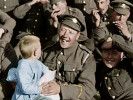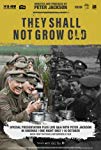Eye For Film >> Movies >> They Shall Not Grow Old (2018) Film Review
They Shall Not Grow Old
Reviewed by: Owen Van Spall

On the centenary of the First World War, Academy Award-winner and Lord Of The Rings maestro Peter Jackson finally presents his long-gestating project made in collaboration with both 14-18 Now and the Imperial War Museum: a new look at the First World War via a roughly chronological collage of colourised and revised archive footage of the men on the frontlines. To be precise, it is specifically a look at the British Western Front in Europe, a region well-known in popular culture as crisscrossed with muddy trenches and sand bags, beyond which lay a murder zone of barbed wire and machine gun nests; ‘No Man’s Land’. Colourising past footage of wars is nothing new, but Jackson’s project is reaching very far back into film history with intent to effect such alterations, as well as making other changes.
They Shall Not Grow Old begins with the kinds of monochrome clips we have long been used to as our window into the filmic record of the First World War. For about 15 minutes, as various audio recordings of reminiscing British veterans provide the soundtrack, we see the young men of Britain begin to mobilise for war back home. ‘Pal’s Battalions’ joining up from the same town, recruits complaining about overbearing military officers, plain-spoken unselfconscious statements about one’s certainty of victory with the might of the British empire behind them. More circumspect voices start to appear, though, with some veterans recalling how it was a time, ‘When men just did what they were told.’ This spread of voices, and the disarming frankness many use to describe the most horrific sights and sounds (and note the surprising lack of bitterness in many testimonials, despite the common belief that the war was widely regarded as ‘not worth it’), remains the strongest element of Jackson’s film, regardless of the visual trickery.

Then, as we are brought to the muddy fields of the Western Front and the first clashes between British and German troops, the frame expands outwards to widescreen, and the colours seep into what was monochrome footage. All the footage beforehand is framed, clumsily in my view, to suggest its ‘oldness’ and unfitness for purpose, in a scrappy 4:3 frame and backed by a fake whirring sound to emulate a classic film strip projector. Each frame of the film that follows in colour was hand-colourised by Jackson’s team, the footage 3D-digitised, and transformed with modern post-production techniques.
To see soldiers in this colourised palette initially, after the eyes have been primed by exposure to monochrome for a quarter hour, is a jarring experience. At times, when a soldier is caught looking at the camera (even then people knew reality was being mediated - "It’s the pictures, mate" some shout) and the frame is sharp enough to see their eye colours and stubble on their face, the moment can serve as a reaffirmation of how people did not see the world in monochrome on those battlefields. Red splashes of blood (this film contains a surprising amount of footage of mangled corpses, both animal and human) also serve as a salutary reminder that people then bled like we do today no matter how much black and white might seem to remove them from what we know to be the realities of the things modern warfare can do to bodies.
Colour or no colour, this footage is soberly compelling because of what it so starkly shows - the painfully recognisable humanity and the incredible mechanical forces ranged against such humans. A transition from a laughing ‘Tommy’ hefting a French child in play to the staggering sight of a mine buried 20ft down detonating upwards in a cyclone of earth is says it all. Then there are the rats, outside toilets that are just benches over shell holes, bodies sunk in mud. Notably absent from these arrays of horrors though are the views of women and soldiers of non-white descent on this carnage, the result of Jacksons’s very narrow focus.
For every moment I felt both lost in thinking; 'So that is what it must have looked like’, there was another where I felt distracted by a certain heavy-handedness in reinterpreting the footage. The colourisation, combined with strange warping effects that presumably come from adjusting the frame rates and maybe even artificially inserting some to create a 24fps mimicry, makes the footage look more like an animated film or rotoscope effort at times. Often the colour palettes fail to appear that distant from the kinds of wistful war posters I have seen.
I have mixed feelings about the use of sound effects, too. The First World War was, of course, not filmed with synchronised sound. Audiences seeing this footage would not have heard shell thumps or soldiers muttering to each other, or screams of pain. Jackson has, through various methods that range from dubbing, to foley and lip readings, given this film a ‘real’ soundtrack. Certainly this allows an evocation of the inferno of the fighting, particular the sheer wall of sound that a barrage creates (when a soldier describes in voiceover his increasing terror as incoming shell screams in, a sonic demonstration certainly adds punch) but I found the dialogue often out of sync with lips, and the idea of a modern actor 'speaking for' a dead person a little uncanny valley. Overall, the effects of Jackson’s interventions into archive material are often startling, and sometimes very transporting and moving, but in my view this film is best approached as more of a well-intentioned artistic reinterpretation of ‘what it must have been like to be there’ than a restoration or a true document. If it spurs sober reflection, an interest in going back to the original footage, and sales of serious books about the First World War, They Shall Not Grow Old will have served its purpose.
Reviewed on: 09 Nov 2018


















